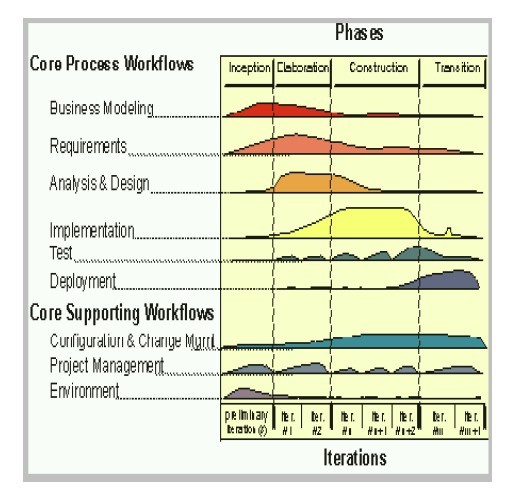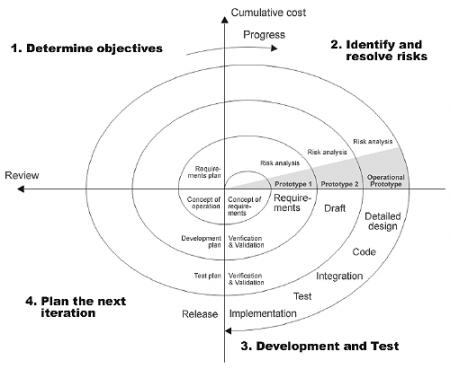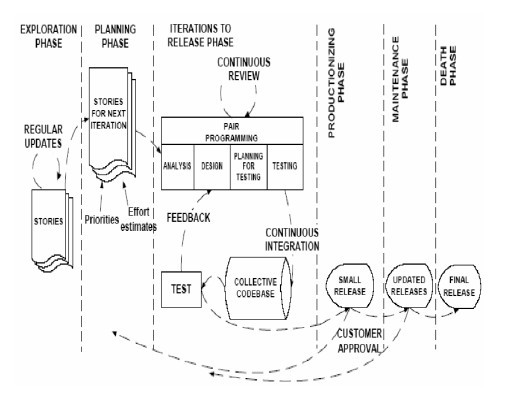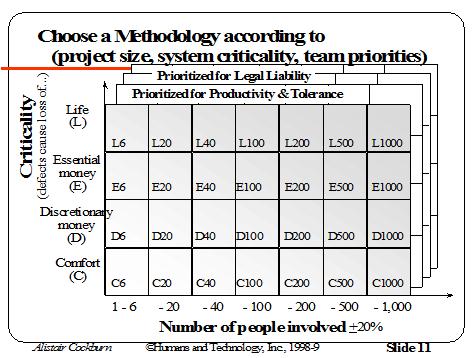CSC/ECE 517 Fall 2011/ch6 6e zj: Difference between revisions
| Line 226: | Line 226: | ||
* Team members, are your team members all senior developers or are there any newbie programmers? | * Team members, are your team members all senior developers or are there any newbie programmers? | ||
* project size, is the project a large-scale project or not? | * project size, is the project a large-scale project or not? | ||
* Existing processes, is there any existing processes that could be applied to the project? | * Existing processes, is there any existing processes that could be applied to the project? | ||
* time cost: what's the deliverable time for the project? How much time do you have to develop the project? | |||
* Software, what kind of software you will develop. | * Software, what kind of software you will develop. | ||
Revision as of 01:45, 22 November 2011
Introduction
The concept of heavier-weight methodology
Traditional methodology which is also known as Heavyweight development methodology that is based on a sequential series of steps, such as requirements definition, solution build, testing and deployment. Heavyweight development methodology mainly focuses detailed documentation, inclusive planning, and extroverted design, its typical example is waterfall model.
The concept of agile methodology
Agile methodology(Lightweight Methodology) is an iterative and incremental approach to project management, typically used in software development. It helps teams respond to the changes of building software quickly and efficiently . <ref name = "agile1">http://acm.web.auth.gr/2011/03/03/agile-methodology/</ref>
Compare with the heavier-weight methodology and agile methodology
Heavier-weight methodology
Heavyweight methodology<ref name = "agile2">http://www.techrepublic.com/article/heavyweight-vs-lightweight-methodologies-key-strategies-for-development/5035285</ref>:
- A heavyweight methodology which is composited with rules, practices, and documents makes us discipline and time to follow correctly.
- Heavyweight methodologies focus in the great detail of the project.
- The specifications, reports, plans, schedules and checkpoints is required by the lead managers.
- For the reason that the heavyweight methodology plans about the requirements, design, etc. before the project is actually started, so the project managers who use heavyweight methodologies will resist change.
- Requirements, solution build, testing and deployment are always the basic steps for the heavyweight development methodology.
- Rational Unified Process is one of the widely used example of “heavyweight” methodology.
- If the project needs multiple teams working at several locations, and you need them to work tighter to develop some core parts of the project, in such condition heavyweight methodologies can be a better choice, because they could adhere to the requirements, design documentation, which will avoid that they work in wrong direction because of inconvenience communication.
Advantage of heavier-weight methodology
- It is a clear and powerful method for software development, many big corporations use this method to develop software. It clearly defines software development life cycle, which help a new developer better know how to develop the software.
- Because we have clear stated what to do before the project actually start, this will save us time to do only those that we actually required. It always happen that a project team do a lot of effort to code and then later found out that it's not required at all. So using this method and adhering closely to documentation, It will avoid of those useless effort.
- The project stakeholders are forced to clearly and correctly define the business requirements documentations. Also, developers are forced to completely understand the requirements before starting doing the high level design and coding. Without thoroughly understand the requirements, they will fail to meed the corresponding milestone and fail to continue the project.
- Actually, making documentation at every state is an very essential step. It helps better understand the requirements, design the code , write code and design test on the software.
Disadvantage of heavier-weight methodology
The traditional project methodologies that many top corporations use, such as the SDLC approach, are considered to be bureaucratic or “predictive” in nature, and they’ve resulted in many unsuccessful projects. These “heavyweight” methodologies are becoming increasingly unpopular. They can be so laborious that the whole pace of design, development, and deployment actually slows down.<ref name = "agile2"/>
Heavyweight methodologies try to plan majority part of the project in great detail.it assumes that every requirement of the project can be identified before any design or coding occurs Project managers need to predict predict every project milestones because they need those technical details, which result in a large number of documentation, such as plans, report, and schedules. However, we know, when doing a project, there are always a lot of changes, such as that the client may change their requirements, then all the schedules, checkpoints made for the project need to get changed. So making all the details for a project before actually starting the project is not an effective way.
Heavyweight development methodology is based on a sequential series of steps, such as requirements, solutions, testing and deployment, which means that every step could only be started with the finish of previous step, while the lightweight methodologies propose to execute the project steps in parallel.
Agile methodology
"In 1970, Dr. Winston Royce presented a paper entitled “Managing the Development of Large Software Systems” which outlined his ideas on sequential development. In essence, his presentation asserted that a project could be developed much like an automobile on an assembly line, in which each piece is added in sequential phases. This means that every phase of the project must be completed before the next phase can begin. Thus, developers first gather all of a project’s requirements, then complete all of its architecture and design, then write all of the code, and so on. There is little, if any, communication between the specialized groups that complete each phase of work."<ref name = "agile3">http://agilemethodology.org/</ref>
Advantage of agile methodology
- The most important characteristics of Agile methodology is that it is adaptive, making the team is able to respond to the change of requirements. We know that it is a quite common thing for requirements to get changed when developing a software.
- The team does not have to invest time and effort and finally find that by the time they delivered the product, the requirement of the customer has changed.
- The close communication from customer and the designer makes all the requirements clear and if somethings changed, the develop team could quickly respond to the change, there is no guesswork here.
- No complicated and burdensome documentation, which saves a lot of time when developing software.
- The outcome is always the software that best satisfy the customer, as they closely communicate during the developing proecess.
In a nutshell this means that you could quickly start a project, and project scope is flexible which means that you could properly manage the project scope during the developing process.
Disadvantage of agile methodology
- In case of some software deliverables, especially the large ones, it is difficult to access the effort required at the beginning of the software development life cycle.
- There is lack of emphasis on necessary designing and documentation. Actually, designing and documentation are important things for software development, they help to different developers to adhere to one "principle policy".
- Sometimes when we are asked to develop a software, even the clients themselves don't know what kind of final outcome they want. In such scenario , the project can easily go into a total dilemma.
- The project can easily get taken off track if the customer representative is not clear what final outcome that they want.
- Only those senior programmers have the ability and power to make some decisions required during the develop process. Thus for those newbie programmer, they have no chances and how they have the opportunity to be an experienced senior programmer?
- For developing large scale software systems, such development methodologies are under critical criticize for their lack of strong planning.
Heavier-weight Methodology VS Agile Methodology
The Difference Between Heavier-weight Methodology and Agile Methodology
| Differences | Agile Methodology | Heavier-weight Methodology | |
|---|---|---|---|
| Requirements | has many changes | Knowable early, stable | |
| Architecture | Designed for current requirements | Designed for current and predicated requirements | |
| Size | Smaller Team and Products | Larger Team and Products | |
| Primary objective | Rapid value | High assurance | |
| Developers | Knowledgeable,collocated,collaborative | Plan-driven,adequate skills,access to external knowledge. | |
| Release cycle | In phases (multiple cycles) | Big bang (all functionality at once) |
The Issue of Heavier-weight Methodology and Agile Methodology<ref name = "agile4">http://www.ijcsi.org/papers/IJCSI-8-4-1-441-450.pdf</ref>
| Issue | Agile Methodology | Heavier-weight Methodology |
|---|---|---|
| Development life cycle | adaptive and incremental | Incremental |
| Style of development | Adaptive | Anticipatory |
| Requirements | Many changes discovered during the project. | Clearly defined and documented before the project started |
| Documentation | Light(depend on face-to-face communication) | detailed documentation based on requirements |
| Team members | senior technical staff | Distributed teams of specialists |
| Client Involvement | considered as a team member Active/proactive for communication | Low involvement |
| Market | Dynamic/Early market | Mature/Main Street market |
| Measure of success | final outcome exactly what the client required | Conformance to plan |
Example
Heavier-weight methodology
Rational Unified Process
Indroduction of RUP
The Rational Unified Process (RUP),which comes from Rational Software and later by IBM, is a kind of heavy methodology which can be use to accomodate the change and adaptability during the development process. These are some features of RUP: it use the incremental iterations to build the software. The development disciplines like requirements, analysis, design, and implementation and testing can be parts of the interation. It help successful developing of the software by assign the tasks and responsibilities for the developing teams.
The Main Goal of RUP
RUP can product the high-quality software for its end-users in a predicatable shcedule and budget. RUP needs some guildlines for best pratices<ref name = "agile4" />:
- Develop software iteratively
- Manage requirements
- Use component-based architectures
- Visual model software
- Verify software quality
- Control changes to software
The Phases of RUP

RUP has a series of phases as follows:
- Inception: In this phase, we should caculate some risks we may face in the future and the costs, eviroment, eviroment ect.
- Elaboration: This phase require us know what needs us to build, and we also should know the detail, make sure the architecture will work in future.
- Construction: In this phase we should build the product according to the documentation required and build the supporting documentation.
- Transition: In this phase the product will release to the user for user tested, we should correct the bug in this phase for future deploying.
Notes:The picture cites from <ref name = "agile4" />
Usage of RUP Model
Below is some usage of RUP Model:<ref name = "agile4" />
- Distributed systems
- Very large or complex systems
- Systems combining several business areas
- Systems reusing other systems
- Distributed development of a system
Spiral Model
Indroduction of Spiral Model
Spiral Model is also known as Boehm's model, by use the advantages of the top-down and bottom-up concepts we can represent the process like a spiral, which quite different with sequence we use in the waterfall model.
Processes in Spiral Model

There are four processes in spiral model:
- Objective setting: We should know what to build and what the goal of project in this process.
- Risk assessment and reduction: We should calculate the key risks we may face in the future work and try our best to reduce the risks.
- Development and Validation: After we resolve all risks of the project, we should choose an appropriate model for our future development.
- Planning: In this phase, we should review the current round of our project and make planning for the spiral next round.
Note: The picture cites from http://en.wikipedia.org/wiki/File:Spiral_model_(Boehm,_1988).png
Usage of Spiral Model
Spiral model may be a better choose for usage in the situations below:
- In a large projects that with high budget.
- The risk assessment plays an important role in the whole project.
- Requirements are not very clearly defined and complex.
- The requirements need to change all the procedure.
- For projects with high risk.
Agile methodology
Extreme Programming(XP)
Indroduction of Extreme Programming(XP)
One of the important agile methodology example is Extreme Programming(XP). It was created by Kent Beck in his C3 project. The goal for Extreme Programming(XP) is to provide high quality software to the user. It consists the following terms to make sure the software productive by this model. Such like The Planning Process, Small Releases, Metaphor etc. With these terms and practices, the programmer can make change to the environment quickly.
XP Terms and Practices

A summary of XP terms and practices is listed below:
- The Planning Process:The desired features of the software, which are communicated by the customer, are combined with cost estimates provided by the programmers to determine what the most important factors of the software are. This stage is sometimes called the Planning Game.
- Small Releases:The software is developed in small stages that are updated frequently, typically every two weeks.
- Metaphor:All members on an XP team use common names and descriptions to guide development and communicate on common terms.
- Simple Design:The software should include only the code that is necessary to achieve the desired results communicated by the customer at each stage in the process. The emphasis is not on building for future versions of the product.
- Testing:Testing is done consistently throughout the process. Programmers design the tests first and then write the software to fulfill the requirements of the test. The customer also provides acceptance tests at each stage to ensure the desired results are achieved.
- Refactoring:XP programmers improve the design of the software through every stage of development instead of waiting until the end of the development and going back to correct flaws.
- Pair Programming:All code is written by a pair of programmers working at the same machine.
- Collective Ownership:Every line of code belongs to every programmer working on the project, so there are no issues of proprietary authorship to slow the project down. Code is changed when it needs to be changed without delay.
- Continuous Integration:The XP team integrates and builds the software system multiple times per day to keep all the programmers at the same stage of the development process at once.
- 40-Hour Week:The XP team does not work excessive overtime to ensure that the team remains well-rested, alert and effective.
- On-Site Customer:The XP project is directed by the customer who is available all the time to answer questions, set priorities and determine requirements of the project.
- Coding Standard:The programmers all write code in the same way. This allows them to work in pairs and to share ownership of the code.
Crystal
Indroduction of Crystal
Crystal Methodologies is a family of methodologies((Crystal Clear, Crystal Yellow, Crystal Orange, etc.)developed by Alistair Cockburn. The word “Crystal” refers to the degree of hardness and the different colors of the methodology in much the same way that a crystal can have various degrees of hardness and variety of colors. The degree of hardness pertains to the use of rigor and ceremony i.e. as the hardness increases the amount of required documentation, processes and procedures increases.
Features and Restrictions of Crystal

Several of the key tenets of Crystal include teamwork, communication, and simplicity, as well as reflection to frequently adjust and improve the process. Like other agile methodologies, Crystal promotes early, frequent delivery of working software, high user involvement, adaptability, and the removal of bureaucracy or distractions.
Crystal methods are denoted by colors. The color of the methods as follows: Clear, Yellow, Orange, Orange Web, Red, Magenta, and Blue. Only three of the methods – Crystal Clear, Orange and Orange Web - have been constructed and actually used on projects.
One of the restrictions of the Crystal methods is that they only address collocated teams. Thus, the Crystal methods would not apply to distributed or offshore teams for which Cockburn offers no recommendation other than to locate the team together at one location.
Rules that are common to all the Crystal Methods
- The project must use incremental development with increments of four months or less with a string preference of one to three months
- The team must hold both pre- and post- reflection with a strong preference for mid-project reflection workshops
How to choose methodology?
What the best model is varies from project to project, there is no fixed answer for which develop methodologies are good, which are bad. The essential points you’ll need to consider when selecting a methodology are<ref name = "agile2" />:
- Budget, what's your estimated budget of the project.
- Team size, how many developer will get involved in the develop process.
- Technology used, what kind of technology will be used in the project.
- Documentation, will you do a lot of detailed documentation?
- Team members, are your team members all senior developers or are there any newbie programmers?
- project size, is the project a large-scale project or not?
- Existing processes, is there any existing processes that could be applied to the project?
- time cost: what's the deliverable time for the project? How much time do you have to develop the project?
- Software, what kind of software you will develop.
When to Avoid the Agile Methodology
Some situations should avoid Agile Methodology if...
- You have to formally document the requirements, design, code, and testing cases during each phase of the software life cycle.
This is usually the case when building an infrastructure application, rather than an application that supports a changeable business process. Infrastructure applications support an entire business unit over a long ROI period, with repeated updates and enhancements expected. These applications are likely to be managed by successive generations of application owners, who will need to inherit documentation from their predecessors, maintain it, and pass it on their successors.
- Deliverables must pass through a chain of approvals and tollgates
Approvals and tollgates are mini-bottlenecks that can slow the momentum of a project, momentum that agile methods are supposed to support. Applications that require phase-end reviews or reviews of major deliverables by senior management, by a PMO, or even an Audit Committee may or may not be candidates for agile methods. Of course, the flip side to this is that agile methods can also help recover momentum lost to approvals and tollgates.
- You have tools to create the software models but not to translate them to the low end software code.
Model-driven development tools that can generate code are proliferating, but the skills necessary to use them effectively are still relatively scarce. Unless you have both the tools AND the skills available, agile methods that depend on such tools need to be approached with caution.
- You need to follow traditional Software management processes and Procedures.
"Traditional" usually means "comfortable". If the business sponsor and users are uncomfortable with anything but traditional ways of developing software, and remain unmoved by the value proposition for agile methods, don't bother.
- Application users are NOT always accessible to you.
Agile management depends on an effective, day-to-day working partnership between the development team, the sponsor, and empowered users. If this partnership does not exist, or is likely to be weak, an agile project will face much higher risks than it should.
Conclusion
Agile methodologies demand that the client is involved as part of the team during the software develop process. This is of course great if the client want to get involved, however it is not the case in real world. A software, especially those large scale software, need a long development life cycle, not all the clients have that much time to take part in the development process. Agile methodologies allow change, and there are sufficient communication between customers and developers such that the developers are delivering software that is definitely what the customer required, and it could essentially reduce the time for developing those functionality not being used.
Heavyweight methodologies sometimes could be a better choice. Consider a scenario that you have multiple teams working at different locations, you may want to have a "principle guidelines" that make all the developer adhere to it thus avoiding going to the wrong way.Also, heavyweight methodologies requires detailed documentation at every stage, it helps better understand the requirements of the project.
How to correctly select a methodologies to develop software is to a great degree dependant on having a clear understanding of the particular develop groups and types of development models. This is of great importance and make the develop team choose a methodologies that meet the needs of the customer requirements and their capacity.
References
<references> </references>
- [1]: http://www.developer.com/design/article.php/3784576/Why-Agile-Projects-Fail.htm
- [2]: http://agilemethodology.org/
- [3]: http://www.versionone.com/Agile101/Methodologies.asp
- [4]: http://www.the-software-experts.de/e_dta-sw-process.htm
- [5]: http://www.agile-methodology.com/
- [6]: http://rationalizedthoughts.blogspot.com/2006/03/choose-methodology-that-suits-your.html
- [7]: http://www.ijcsi.org/papers/IJCSI-8-4-1-441-450.pdf
- [8]: http://www.techrepublic.com/article/heavyweight-vs-lightweight-methodologies-key-strategies-for-development/5035285
- [9]: http://practicalanalyst.com/2009/03/16/agile-and-traditional-methodologies-compared-again/
- [10]: http://en.wikipedia.org/wiki/IBM_Rational_Unified_Process
- [11]: http://en.wikipedia.org/wiki/Spiral_model
- [12]: http://en.wikipedia.org/wiki/Extreme_programming
- [13]: http://en.wikipedia.org/wiki/The_Crystal_Method
- [14]: http://en.wikipedia.org/wiki/Lightweight_methodology
- [15]: http://www.cs.umd.edu/class/spring2003/cmsc838p/Process/waterfall.pdf